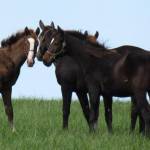Nutritional Considerations for Foals at Weaning

Weaning is a time of major transition for foals, both nutritionally and psychologically. In addition to being separated from their dams, milk becomes completely absent from the diet. Following weaning, foals must acquire all of their nutrition from forage and a concentrate. Because weaning is a significant stressor, foals are also at high risk for developing gastric ulcers.
Management strategies can be implemented to help minimize the stress of weaning. Most foals will begin to nibble at the dam’s grain within a few days or weeks of life. However, in the first few months of life, the digestive enzymes amylase and protease have low activity in the foal, making it difficult to digest grains properly. Therefore, concentrate offerings for a foal under three months of age, if necessary at all, should contain about 18% crude protein and a whey-based (from milk) protein source for ease of digestion.
When foals turn three months old or so, they are better able to digest grains and forage. “Grain concentrates designed for broodmares and growing horses typically contain about 16% crude protein plus the essential amino acids lysine, methionine, and threonine. Fat content should be moderate to high, between 6-10%,” said Kathleen Crandell, Ph.D., a nutritionist for Kentucky Equine Research.
Often the foal and dam can consume the same concentrate at this stage, which is why most foals do well by sharing with their dams. By nibbling on concentrate and forages, foals gradually become introduced to different feedstuffs, which allows their digestive tract time to adapt to the new feeds prior to weaning.
The amount of concentrate given after weaning will depend on the foal’s weight and the manufacturer’s directions. An example of how to begin feeding concentrates to a foal is to start slowly and work up to 1% of the foal’s body weight per day, or one pound of feed per month of age. Two to three weeks before weaning, begin increasing the amount of grain offered to the foal, but no more than 1% of body weight.
“The foal may be swiping this much from its dam’s feed bucket prior to weaning, so there may be little need to acclimate a foal to the feed slowly. Observing the foal’s eating patterns prior to weaning could offer insight into how to best transition the foal,” said Crandell.
Fast-growing foals that tend to carry a lot of weight can be fed a balancer pellet, which will provide the nutrients necessary to foster sound growth without an overabundance of calories. Foals on high-quality pasture often do well on balancer pellets. Balancer pellets would also be appropriate for foals that show signs of epiphysitis, which is inflammation of the joints often brought on by overconsumption of energy and unchecked growth, said Crandell.
High-quality pasture or hay will meet the forage requirements of weanlings. If feeding hay, look for clean, weed-free hay that has been harvested in early growth stages. The hay should not be too stemmy or have a profusion of seed heads, as these may indicate the hay was baled in a late stage of growth. Forage should be offered free-choice.
During weaning, foals often lose their appetite temporarily, often for only a meal or two. Prolonged inappetence can slow growth and set the stage for gastric ulcers. For this reason, be cognizant of appetite during the weaning process. Ideally, foals should grow at a steady pace, avoiding spurts and lapses, but weaning can throw a wrench in the works. Prior adaptation to concentrate feed and forage helps.
Remember, horses are herd animals with social needs. A weanling will do well with company, such as other weanlings, an older, sedate horse, or even a calf or donkey.
Following weaning, watch for signs of ulcers that may include colic-like symptoms, loss of appetite, weight loss, ratty hair coat, and slow growth.
Key points of weanling nutrition:
- Feeding concentrates by three months of age will help a young foal’s digestive system prepare for the acquisition of nutrients once milk is removed from the diet.
- Balanced minerals, especially calcium, phosphorus, zinc, and copper, along with complete proteins, are critical to a developing foal’s health. Well-formulated feeds offered at suggested intakes will take care of these requirements.
- Good-quality forage is essential, with the best forage being well-tended pasture or early-maturity hay.
- Aim for steady, consistent growth, avoiding sharp accelerations or slowdowns.
- Seek veterinary advice if weanlings begin to lose appetite, look poor or ribby, or develop swollen joints or unsoundness, however slight.
The nutrition advisors at Kentucky Equine Research are available to answer your questions about properly feeding weanlings. Contact us today!








